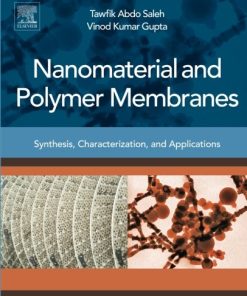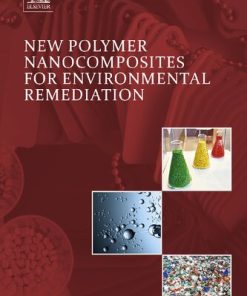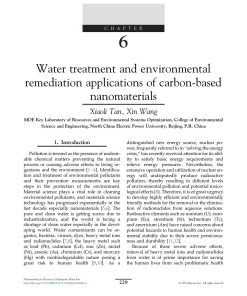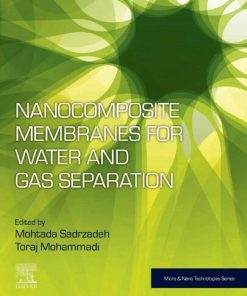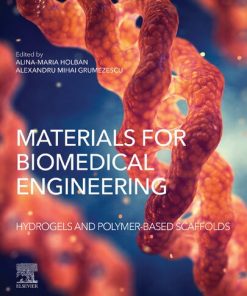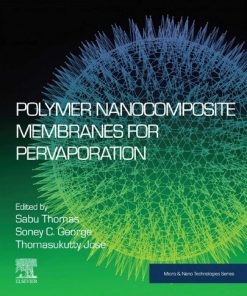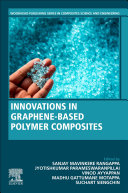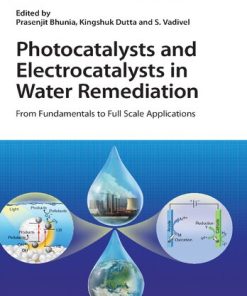Advancement in Polymer Based Membranes for Water Remediation 1st edition by Sanjay Nayak 0323885171 9780323885171
$50.00 Original price was: $50.00.$25.00Current price is: $25.00.
Advancement in Polymer-Based Membranes for Water Remediation 1st edition by Sanjay K. Nayak – Ebook PDF Instant Download/DeliveryISBN: 0323885171, 9780323885171
Full download Advancement in Polymer-Based Membranes for Water Remediation 1st edition after payment.
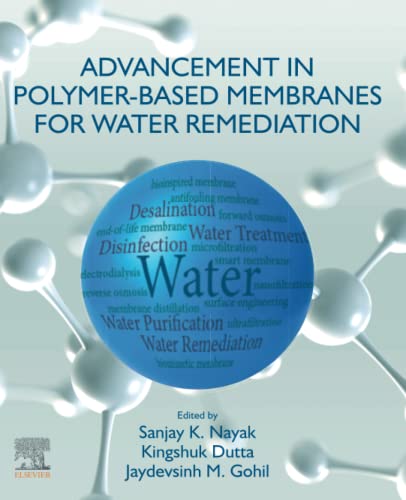
Product details:
ISBN-10 : 0323885171
ISBN-13 : 9780323885171
Author : Sanjay K. Nayak
Advancements in Polymer-Based Membranes for Water Remediation describes the advanced membrane science and engineering behind the separation processes within the domain of polymer-based membrane systems in water remediation. Emphasis has been put on several aspects, ranging from fundamental concepts to the commercialization of pressure and potential driven membranes, updated with the latest technological progresses, and relevant polymer materials and application potential towards water treatment systems. Also included in this book are advances in polymers for membrane application in reverse osmosis, nanofiltration, ultrafiltration, microfiltration, forward osmosis, and polymeric ion-exchange membranes for electrodialysis and capacitive deionization.
Advancement in Polymer-Based Membranes for Water Remediation 1st Table of contents:
Section I: Water remediation using polymeric microfiltration and ultrafiltration membrane technologies
Chapter 1. Microfiltration and ultrafiltration membrane technologies
Abstract
1.1 Introduction
1.2 Membrane science and theory
1.3 Membrane characterization methods
1.4 Module design and process configuration
1.5 Application of polymeric ultrafiltration and microfiltration membranes
1.6 Summary
References
Chapter 2. Polymer-based microfiltration/ultrafiltration membranes
Abstract
2.1 Introduction
2.2 Polymers as raw material to synthesize microfiltration/ultrafiltration membranes
2.3 Effect of polymer-enhanced microfiltration/ultrafiltration membranes
2.4 Recent advances made in polymeric microfiltration/ultrafiltration membranes for water remediation application
2.5 Microplastics and polymeric membranes
2.6 Prospective
References
Chapter 3. Polymer-based nano-enhanced microfiltration/ultrafiltration membranes
Abstract
3.1 Introduction
3.2 Nanocomposite membranes
3.3 Hollow fiber nano-enhanced membranes
3.4 Main aspects in membrane performances
3.5 Carbon nanotubes and graphene oxide
3.6 Metallic nanoparticles
3.7 Stability of nanocomposite membranes
3.8 Future research
3.9 Challenges and future perspectives
3.10 Conclusions
References
Further reading
Section II: Water remediation using polymeric nanofiltration membrane technologies
Chapter 4. Nanofiltration membrane technologies
Abstract
4.1 Introduction
4.2 Operation principle and transport mechanism
4.3 Types of polymeric membranes and application domain
4.4 Polymeric membrane structure and configurations
4.5 NF membrane preparation technologies
4.6 Commercially available membranes
4.7 Limitations and key mitigation strategies
4.8 Summary and future directions
References
Chapter 5. Polymer-based nanofiltration membranes
Abstract
5.1 Introduction
5.2 Polymer-based nanofiltration membranes
5.3 Preparation of polymer-based nanofiltration membranes
5.4 Thin-film polymer composite nanofiltration membranes
5.5 Effect of polymeric support
5.6 Potential of polymer-composite nanofiltration membranes for water desalination
5.7 Polymers for solvent-resistant nanofiltration membranes
5.8 Commercialization status and commercial viability
5.9 Summary and future direction
References
Chapter 6. Polymer-based nanoenhanced nanofiltration membranes
Abstract
6.1 Introduction
6.2 Mixed matrix polymer-based nanoenhanced nanofiltration membranes
6.3 Electrospun nanofibrous polymers for nanofiltration applications
6.4 Nanoenhanced hollow-fiber nanofiltration membranes
6.5 Commercialization status and commercial viability
6.6 Summary and future directions
Abbreviations
References
Chapter 7. Polymer-based bioinspired, biomimetic, and stimuli-responsive nanofiltration membranes
Abstract
7.1 Introduction
7.2 Bioinspired membranes and their applications
7.3 Biomimetic membranes
7.4 Stimuli-responsive/smart membranes
7.5 Commercial status and future directions
7.6 Summary
Nomenclature
References
Section III: Water remediation using polymeric reverse and forward osmosis membrane technologies
Chapter 8. Reverse and forward osmosis membrane technologies
Abstract
8.1 Introduction
8.2 Classification of osmotic processes and basic concept
8.3 Reverse osmosis and forward osmosis membranes
8.4 Concentration polarization in an osmotic-driven membrane
8.5 Reverse osmosis and forward osmosis membrane fabrication methods
8.6 Advances in forward osmosis and reverse osmosis membranes’ structures and properties
8.7 Custom designs of flat sheet forward osmosis and reverse osmosis membranes
8.8 Concluding remarks and recommendations
References
Chapter 9. Polymer-based reverse osmosis membranes
Abstract
9.1 Introduction
9.2 Asymmetric polymer-based reverse osmosis membranes
9.3 Thin-film composite membrane
9.4 Potential of different polymer-based reverse osmosis membranes for brackish water desalination
9.5 Polymer-based reverse osmosis membranes for seawater desalination
9.6 Commercialization status and commercial viability
9.7 Summary and future direction
References
Chapter 10. Polymer-based nano-enhanced reverse osmosis membranes
Abstract
10.1 Introduction
10.2 Preparation strategies of polymer-based nano-enhanced reverse osmosis membranes
10.3 Polymer nanocomposite reverse osmosis membranes
10.4 Potential of different polymer-based nanocomposite reverse osmosis membranes for water desalination
10.5 Potential other applications of polymer nanocomposite reverse osmosis membranes in water treatment
10.6 Commercialization status and viability
10.7 Way forward
10.8 Conclusion
Acknowledgment
References
Chapter 11. Reuse and recycling of end-of-life reverse osmosis membranes
Abstract
11.1 Introduction
11.2 Reverse osmosis membrane technology
11.3 Reverse osmosis membranes and modules
11.4 Fouling in reverse osmosis separation process: problem, prevention, and cleaning protocols
11.5 End-of-life reverse osmosis membrane modules: reuse and recycling techniques
11.6 Applications of reverse osmosis recycled membranes in other membrane processes
11.7 Conclusions
Acknowledgments
References
Chapter 12. Polymer-based forward osmosis membranes
Abstract
12.1 Introduction
12.2 Polymer-based flat sheet forward osmosis membranes
12.3 Polymer-based hollow fiber forward osmosis membranes
12.4 Commercialization status and commercial viability
12.5 Summary and future directions
Abbreviations
Nomenclature
References
Chapter 13. Polymer-based nano-enhanced forward osmosis membranes
Abstract
13.1 Introduction
13.2 Polymer-based mixed matrix forward osmosis membranes
13.3 Polymer-based nanocomposite flat sheet forward osmosis membranes
13.4 Polymer-based nanocomposite hollow fiber forward osmosis membranes
13.5 Nanofibrous-based forward osmosis membranes
13.6 Nanomaterials used in surface modification of forward osmosis membranes
13.7 Polymer-based stimuli-responsive forward osmosis membranes
13.8 Commercialization status of the forward osmosis membranes
13.9 Summary and future directions
References
Section IV: Water remediation using polymeric membranes in electrodialysis, electrodialysis reversal, capacitive deionization and membrane distillation technologies
Chapter 14. Electrodialysis, electrodialysis reversal and capacitive deionization technologies
Abstract
14.1 Introduction
14.2 Structure of ion-exchange membranes
14.3 Electrodialysis, electrodialysis reversal, and selective electrodialysis
14.4 Capacitive deionization-based technologies
14.5 Limitations and key mitigation strategies
14.6 Summary and future directions
Acknowledgments
References
Chapter 15. Polymeric membranes in electrodialysis, electrodialysis reversal, and capacitive deionization technologies
Abstract
15.1 Introduction
15.2 Ion-exchange membranes and their fabrication processes
15.3 Application and performance of ion-exchange membranes in electrodialysis
15.4 Application and performance of ion-exchange membranes in electrodialysis reversal
15.5 Application and performance of ion-exchange membranes in membrane capacitive deionization
15.6 Concluding remarks
References
Chapter 16. Polymeric nano-enhanced membranes in electrodialysis, electrodialysis reversal and capacitive deionization technologies
Abstract
16.1 Introduction
16.2 Preparation of polymer-based nano-enhanced ion-exchange membranes
16.3 Analysis of different ion-exchange membranes for water treatment
16.4 Commercialization status and commercial viability
16.5 Summary and future directions
References
Chapter 17. Polymer-based membranes for membrane distillation
Abstract
Abbreviations
Nomenclature
17.1 Introduction
17.2 Principle and different configurations of membrane distillation
17.3 Fabrication techniques and module designs of MD membrane
17.4 Membrane materials for MD
17.5 Characteristics of MD membrane
17.6 Operational parameters in membrane distillation
17.7 Fouling and wetting phenomena
17.8 Prevention methods of fouling and wetting
17.9 Temperature and concentration polarization
17.10 Applications of membrane distillation
17.11 Economics and energy consumption of membrane distillation
17.12 Conclusion and future directions in membrane distillation
People also search for Advancement in Polymer-Based Membranes for Water Remediation 1st:
cell membrane polymer
polymer membranes
advanced functional polymer membranes
hydrogel membrane
polymer membrane synthesis
Tags: Advancement, Polymer Based, Membranes, Water Remediation, Sanjay Nayak
You may also like…
Chemistry - Biochemistry
Biology and other natural sciences - Ecology
Engineering - Bioengineering
Engineering
Physics - States of Matter
Innovations in Graphene-Based Polymer Composites1st Edition Sanjay Mavinkere Rangappa
Chemistry - Technical & Industrial Chemistry




